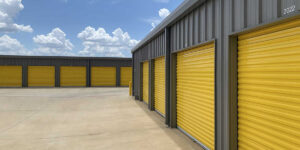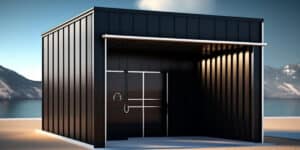Maximizing Durability and Efficiency: How to Design a Strong Foundation for Your Shipping Container Garage
When it comes to building a shipping container garage, one of the most critical aspects to consider is the foundation. A strong and well-designed foundation not only ensures the durability of your structure but also maximizes its efficiency. In this article, we will explore the key considerations and steps to design a robust foundation for your shipping container garage.
Assess the Site
Before starting any construction project, it is essential to assess the site where your shipping container garage will be located. Consider the soil conditions, drainage patterns, and any potential environmental factors that may impact the stability of your foundation. This assessment will help you determine the appropriate foundation design for your specific location.
Choose the Right Foundation Type
There are several foundation types to choose from when building a shipping container garage. The most common options include:
-
Concrete Slab Foundation: This is a popular choice for shipping container garages due to its simplicity and cost-effectiveness. A concrete slab provides a stable and level base for the containers, ensuring proper weight distribution.
-
Pier Foundation: If your site has uneven terrain or poor soil conditions, a pier foundation might be the ideal solution. Piers are strategically placed to support the corners and midpoints of the containers, providing stability and load-bearing capacity.
-
Trench Foundation: Suitable for areas with high water tables, a trench foundation involves excavating a trench and filling it with gravel or crushed stone. This design allows for proper drainage and prevents water from seeping into the containers.
Consider the specific requirements of your site and consult with a structural engineer or foundation specialist to determine the best foundation type for your shipping container garage.
Reinforce with Footings and Anchors
To further enhance the strength and stability of your foundation, it is crucial to incorporate footings and anchors. Footings are reinforced concrete pads placed beneath load-bearing points of the containers. They help distribute the weight evenly and prevent settlement or sinking.
Anchors, such as ground screws or helical piles, are used to secure the containers to the foundation. These anchors provide additional stability, ensuring that your shipping container garage can withstand external forces, such as high winds or earthquakes.
Consider Insulation and Moisture Control
While designing your foundation, it is also essential to consider insulation and moisture control measures. Insulating the foundation can help regulate temperature and reduce energy consumption within the shipping container garage. Additionally, incorporating moisture barriers and proper ventilation systems will prevent condensation and moisture buildup, which can lead to structural damage and corrosion.
Follow Local Building Codes and Regulations
Before starting any construction project, it is crucial to familiarize yourself with local building codes and regulations. Building codes vary from region to region, and compliance is essential to ensure the safety and legality of your shipping container garage. Consult with local authorities or a building professional to ensure your foundation design meets all necessary requirements.
Conclusion
Designing a strong foundation for your shipping container garage is a critical step in maximizing its durability and efficiency. Assessing the site, choosing the right foundation type, reinforcing with footings and anchors, considering insulation and moisture control, and following local building codes will all contribute to a solid and long-lasting foundation. By investing time and effort into this crucial aspect of your project, you will be well on your way to creating a functional and resilient shipping container garage that will stand the test of time.
Step-by-Step Instructions for Creating a Solid Foundation for Your Shipping Container Garage
If you’re considering building a shipping container garage, one of the most crucial steps in the process is creating a solid foundation. A strong and stable foundation is essential to ensure the structure’s durability and longevity. In this section, we will provide you with a step-by-step guide on how to create a solid foundation for your shipping container garage.
Step 1: Choose the Right Location
Before you start constructing your foundation, it’s important to carefully choose the location for your shipping container garage. Look for a level and well-drained area that can support the weight of the containers and any vehicles or equipment you plan to store inside. Avoid areas prone to flooding or areas with poor soil conditions.
Step 2: Obtain the Necessary Permits
Before you begin any construction work, it’s important to check with your local authorities to determine if you need any permits or approvals for building your shipping container garage foundation. Each municipality may have different regulations, so it’s crucial to comply with local building codes.
Step 3: Clear and Level the Site
Once you have chosen the location and obtained the necessary permits, clear the site of any vegetation, debris, or obstacles that could hinder the construction process. Use a shovel, rake, or other suitable tools to level the area and ensure a smooth surface for the foundation.
Step 4: Excavate the Foundation Trenches
Next, you’ll need to excavate the foundation trenches. The depth and width of the trenches will depend on the size and weight of the shipping containers. Generally, the trenches should be at least 12 inches deep and 16 inches wide. Use a measuring tape and string lines to ensure the trenches are straight and level.
Step 5: Install Formwork
To create a formwork for your foundation, you can use wooden boards or metal stakes and plywood. Install the formwork along the edges of the trenches, ensuring they are properly secured and level. This will help contain the concrete and provide a neat and defined shape for the foundation.
Step 6: Compact the Soil
Before pouring the concrete, it’s important to compact the soil within the foundation trenches. Use a soil compactor or a hand tamper to ensure the soil is firmly packed, which will help prevent settling and shifting of the foundation in the future.
Step 7: Lay a Gravel Base
To enhance the stability of your foundation, lay a layer of compacted gravel at the bottom of the trenches. This will provide additional support and help with drainage. Aim for a layer of gravel that is around 4 inches thick and level it using a rake or compactor.
Step 8: Pour the Concrete
Once the soil and gravel base are prepared, you can now pour the concrete into the foundation trenches. Mix the concrete according to the manufacturer’s instructions and use a wheelbarrow or concrete mixer to transport it to the site. Fill the trenches evenly, ensuring the concrete reaches the top of the formwork.
Step 9: Smooth and Level the Concrete
After pouring the concrete, use a screed board or a long, straight piece of lumber to smooth and level the surface. Move the screed board back and forth in a sawing motion, using the formwork as a guide. This will help remove any excess concrete and create a flat and even finish.
Step 10: Allow the Concrete to Cure
Finally, allow the concrete to cure and harden for at least 7 to 10 days before proceeding with any further construction. During this time, protect the foundation from excessive moisture and temperature fluctuations, as this can affect the curing process.
By following these step-by-step instructions, you can create a solid foundation for your shipping container garage. Remember to always prioritize safety and consult with professionals if you have any doubts or concerns. With a strong foundation in place, you’ll be well on your way to constructing a durable and functional shipping container garage.
Why a Shipping Container Garage Foundation is Worth the Investment: Benefits and Advantages
When it comes to building a garage, choosing the right foundation is crucial. A strong and sturdy foundation ensures the longevity and stability of the structure. In recent years, shipping container garages have gained popularity due to their versatility, durability, and affordability. One of the key components of a shipping container garage is its foundation, which plays a vital role in supporting the weight of the structure and protecting it from potential damage. In this blog post, we will explore the benefits and advantages of investing in a shipping container garage foundation.
1. Stability and Durability
A solid foundation is the backbone of any structure, and a shipping container garage is no exception. By opting for a proper foundation, you ensure the stability and durability of your garage. Shipping container garages are typically built using concrete slab foundations, which provide a solid base for the structure. These foundations help distribute the weight of the garage evenly, preventing any uneven settling or shifting over time. With a stable and durable foundation, you can rest assured that your garage will stand the test of time, even in harsh weather conditions.
2. Protection from Moisture and Pests
Moisture and pests can wreak havoc on any structure, leading to costly repairs and maintenance. One of the advantages of a shipping container garage foundation is that it offers protection against these potential threats. By elevating the structure off the ground, the foundation prevents moisture from seeping into the garage. This is particularly important in areas prone to flooding or heavy rainfall. Additionally, a raised foundation helps deter pests such as rodents and insects from entering the garage, safeguarding your belongings and reducing the risk of damage.
3. Easy Installation and Cost-Effectiveness
When compared to traditional garage foundations, shipping container garage foundations offer a more convenient and cost-effective solution. The installation process is relatively simple and straightforward, making it an ideal choice for DIY enthusiasts. With the right tools and materials, you can lay a concrete slab foundation for your shipping container garage in a relatively short amount of time. This not only saves you money on labor costs but also allows you to customize and personalize your garage according to your specific needs and preferences.
4. Versatility and Adaptability
Shipping container garages are known for their versatility and adaptability. They can be easily modified and customized to suit various purposes, such as a workshop, storage space, or even a living area. The foundation plays a crucial role in supporting these modifications and ensuring the structural integrity of the garage. Whether you decide to add windows, doors, or partitions, a solid foundation will provide the necessary stability and support. This flexibility allows you to transform your shipping container garage into a functional and practical space that meets your unique requirements.
5. Environmental Sustainability
In today’s world, environmental sustainability is becoming increasingly important. Opting for a shipping container garage foundation aligns with this ethos. By repurposing shipping containers, you are reducing waste and promoting recycling. Additionally, using a concrete slab foundation minimizes the need for excavation and reduces the environmental impact associated with traditional foundations. This eco-friendly approach not only benefits the planet but also contributes to the overall appeal and value of your property.
In conclusion, investing in a shipping container garage foundation offers numerous benefits and advantages. From stability and durability to protection against moisture and pests, a proper foundation ensures the longevity and functionality of your garage. The easy installation process, cost-effectiveness, versatility, and environmental sustainability make this type of foundation a worthwhile investment. So, if you’re considering building a shipping container garage, don’t overlook the importance of a solid foundation – it’s the key to a successful and long-lasting structure.
The Ultimate Guide to Building a Shipping Container Garage Foundation: Everything You Need to Know
Are you considering building a shipping container garage but unsure about how to lay a solid foundation? Don’t worry, we’ve got you covered! In this ultimate guide, we will walk you through everything you need to know about building a shipping container garage foundation.
Why is a Solid Foundation Important?
Before we dive into the specifics of building a foundation, let’s talk about why it is crucial. A solid foundation provides stability, durability, and longevity to your shipping container garage. It ensures that your structure remains level, protects against moisture, and prevents any potential damage caused by shifting or settling.
Assessing the Site
The first step in building a shipping container garage foundation is to assess the site where you plan to construct it. Look for a level area that is free from any obstructions such as trees, rocks, or utility lines. Ensure that the soil is stable and capable of supporting the weight of the shipping container and any additional load you plan to put on it.
Types of Foundation
There are different types of foundations you can choose from based on your budget, soil conditions, and local building codes. Here are a few popular options:
-
Concrete Slab Foundation: This is the most common and recommended foundation type for shipping container garages. It involves pouring a concrete slab directly on the ground, providing a stable and level surface for the container to sit on.
-
Pier Foundation: If your site has unstable soil or you want to elevate the shipping container, a pier foundation might be a suitable option. It involves digging holes and pouring concrete footings to support individual piers, which then support the container.
-
Steel Piers: Another option is using steel piers to support the weight of the shipping container. This type of foundation is especially useful if you are building on uneven terrain or in areas prone to flooding.
Preparing the Site
Once you’ve chosen the type of foundation, it’s time to prepare the site. Here’s what you need to do:
-
Clear the Area: Remove any vegetation, rocks, or debris from the site. Level the ground using a shovel or a bobcat if necessary.
-
Mark the Layout: Use stakes and string to mark the outline of the shipping container garage. This will help you visualize the space and ensure that the foundation is built to the correct dimensions.
-
Excavation: If you’re building a concrete slab foundation, you’ll need to excavate the area to a depth of about 4 to 6 inches. If you’re using a pier foundation, dig holes for the footings according to the required specifications.
Building the Foundation
Now that the site is prepared, it’s time to start building the foundation. Here are the steps involved:
-
Formwork: For a concrete slab foundation, you’ll need to build formwork using wooden boards. This will create a mold for pouring the concrete.
-
Reinforcement: Install steel rebar or wire mesh within the formwork to reinforce the concrete and prevent cracking.
-
Pouring the Concrete: Mix the concrete according to the manufacturer’s instructions and pour it into the formwork. Use a screed board to level the surface and remove any excess concrete.
-
Curing: Allow the concrete to cure for the recommended time, usually around 7 days. During this period, protect the foundation from excessive moisture, extreme temperatures, and heavy loads.
-
Installing Piers: If you’re using a pier foundation, follow the specifications provided by the manufacturer to install the piers and footings. Ensure that they are level and properly aligned.
Conclusion
Building a solid foundation is a crucial step in constructing a shipping container garage. By assessing the site, choosing the right foundation type, preparing the site, and following the construction process, you can ensure the stability and longevity of your structure. Remember to check local building codes and regulations before starting your project. Now that you have all the information you need, it’s time to get started on creating your dream shipping container garage!
Exploring Different Foundation Options for Shipping Container Garages: Which One is Right for You?
When it comes to building a shipping container garage, one of the most important decisions you will need to make is choosing the right foundation. The foundation plays a crucial role in the stability, durability, and longevity of your structure. There are several foundation options available, each with its own advantages and considerations. In this article, we will explore some of the different foundation options for shipping container garages to help you determine which one is right for you.
1. Concrete Slab Foundation
A concrete slab foundation is a popular choice for shipping container garages due to its strength and stability. It involves pouring a concrete slab directly onto the ground, providing a solid base for your structure. This foundation option offers excellent load-bearing capacity, making it suitable for heavy-duty applications.
One advantage of a concrete slab foundation is its durability. It can withstand various weather conditions and is resistant to moisture and pests. Additionally, a concrete slab can provide a level surface for your garage, making it easier to park vehicles and store items.
However, it is important to note that constructing a concrete slab foundation requires excavation and proper site preparation. This process can be time-consuming and costly, especially if the ground conditions are not favorable. Additionally, if you plan on relocating your shipping container garage in the future, a concrete slab foundation may not be the most suitable option.
2. Pier Foundation
A pier foundation is another popular option for shipping container garages, particularly for those looking for a more flexible and cost-effective solution. This type of foundation involves placing concrete piers or footings at strategic points to support the weight of the structure.
Pier foundations are advantageous in many ways. First, they require less excavation and site preparation compared to a concrete slab foundation, making them a more budget-friendly option. They also allow for easy customization, as you can adjust the number and placement of piers to meet your specific needs.
Furthermore, pier foundations offer good stability and can be suitable for various soil conditions. They also provide better ventilation and airflow under the shipping container, helping to prevent moisture buildup and potential issues with condensation.
However, it is essential to ensure proper spacing and alignment of the piers to maintain the structural integrity of the garage. Consulting with a structural engineer or a professional contractor is recommended to ensure the piers are placed correctly.
3. Helical Pile Foundation
For those looking for a foundation option that is both versatile and environmentally friendly, a helical pile foundation is worth considering. This type of foundation involves screwing helical piles into the ground to create a stable base for the shipping container garage.
Helical piles offer several advantages. Firstly, they can be installed quickly and efficiently, reducing construction time and costs. They also have a minimal impact on the environment, as they do not require extensive excavation or the use of concrete.
Additionally, helical piles are highly adaptable and can be installed in various soil conditions, including rocky or sloped terrains. This makes them a great option for areas with challenging ground conditions.
However, it is important to note that helical piles may not be suitable for extremely heavy structures or areas with high water tables. Consulting with a professional engineer is crucial to ensure the appropriate design and installation of the helical pile foundation.
4. Elevated Foundation
An elevated foundation involves raising the shipping container garage above the ground using piers or stilts. This foundation option is particularly useful in areas prone to flooding or in situations where a level surface is not readily available.
Elevated foundations offer excellent protection against water damage, as they keep the structure above potential floodwaters. They also provide additional storage space underneath the garage, which can be utilized for various purposes.
However, it is important to consider the additional costs associated with an elevated foundation, including the construction of stairs or ramps for easy access. Furthermore, elevated foundations may require additional reinforcement to ensure the stability and structural integrity of the garage.
Conclusion
Choosing the right foundation for your shipping container garage is an important decision that should not be taken lightly. Each foundation option has its own advantages and considerations, depending on factors such as budget, soil conditions, and local regulations.
Whether you opt for a concrete slab, pier foundation, helical pile foundation, or an elevated foundation, it is crucial to consult with professionals to ensure proper design and construction. By selecting the right foundation, you can ensure the stability, durability, and longevity of your shipping container garage, creating a functional and reliable space for your needs.





